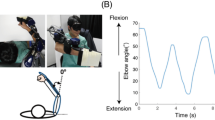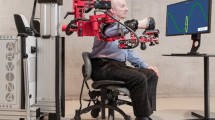Abstract
We propose a learning support system with extremely low latency and low cognitive load to correct the user’s motion. In previous studies, visual and haptic feedback has been mainly used to support motion learning, but there is a delay between the presentation of the stimulus and the modification of the action. However, this delay is due to reaction time and cognitive load and is difficult to shorten. This study proposed a system for solving this problem by combining Electrical Muscle Stimulation (EMS) and prediction of the user’s motion. In order to improve the control ability of the underhand throwing, we used the system to tell the subject the release point during the underhand throwing motion and verified the learning effect. This experiment revealed that EMS tended to be effective in teaching the ball’s release point, although it did not improve the control ability of the underhand throwing motion. In addition, although the effectiveness of EMS for motion learning was not yet fully evaluated, this study showed the possibility of applying EMS to support learning of motion.
Access this chapter
Tax calculation will be finalised at checkout
Purchases are for personal use only
Similar content being viewed by others
Notes
- 1.
NatnetSDK: https://optitrack.com/software/natnet-sdk.
References
Anderson, F., Grossman, T., Matejka, J., Fitzmaurice, G.: YouMove: enhancing movement training with an augmented reality mirror. In: Proceedings of the 26th Annual ACM Symposium on User Interface Software and Technology, UIST 2013, pp. 311–320. Association for Computing Machinery, New York (2013). https://doi.org/10.1145/2501988.2502045
Choi, S., Kuchenbecker, K.J.: Vibrotactile display: perception, technology, and applications. Proc. IEEE 101(9), 2093–2104 (2013). https://doi.org/10.1109/JPROC.2012.2221071
Cmentowski, S., Krueger, J.: Exploring the potential of vertical jump training in virtual reality, pp. 179–185. Association for Computing Machinery, New York (2021). https://doi.org/10.1145/3450337.3483503
Dearborn, K., Ross, R.: Dance learning and the mirror: comparison study of dance phrase learning with and without mirrors. J. Dance Educ. 6(4), 109–115 (2006). https://doi.org/10.1080/15290824.2006.10387323
Ebisu, A., Hashizume, S., Suzuki, K., Ishii, A., Sakashita, M., Ochiai, Y.: Stimulated percussions: method to control human for learning music by using electrical muscle stimulation. In: Proceedings of the 8th Augmented Human International Conference, AH 2017. Association for Computing Machinery, New York (2017). https://doi.org/10.1145/3041164.3041202
Fujii, K., Russo, S.S., Maes, P., Rekimoto, J.: MoveMe: 3D haptic support for a musical instrument. In: Proceedings of the 12th International Conference on Advances in Computer Entertainment Technology, ACE 2015. Association for Computing Machinery, New York (2015). https://doi.org/10.1145/2832932.2832947
Higuchi, K., Shimada, T., Rekimoto, J.: Flying sports assistant: external visual imagery representation for sports training. In: Proceedings of the 2nd Augmented Human International Conference, AH 2011. Association for Computing Machinery, New York (2011). https://doi.org/10.1145/1959826.1959833
Houri, N., Arita, H., Sakaguchi, Y.: Audiolizing body movement: its concept and application to motor skill learning. In: Proceedings of the 2nd Augmented Human International Conference, AH 2011. Association for Computing Machinery, New York (2011). https://doi.org/10.1145/1959826.1959839
Jiang, S., Rekimoto, J.: Mediated-timescale learning: manipulating timescales in virtual reality to improve real-world tennis forehand volley. In: 26th ACM Symposium on Virtual Reality Software and Technology, VRST 2020. Association for Computing Machinery, New York (2020). https://doi.org/10.1145/3385956.3422128
Kono, M., Takahashi, T., Nakamura, H., Miyaki, T., Rekimoto, J.: Design guideline for developing safe systems that apply electricity to the human body. ACM Trans. Comput.-Hum. Interact. 25(3), 1–36 (2018). https://doi.org/10.1145/3184743
Liebermann, D.G., Katz, L., Hughes, M.D., Bartlett, R.M., McClements, J., Franks, I.M.: Advances in the application of information technology to sport performance. J. Sports Sci. 20, 755–769 (2002). https://doi.org/10.1080/026404102320675611
Lin, T., et al.: Towards an understanding of situated AR visualization for basketball free-throw training. Association for Computing Machinery, New York (2021). https://doi.org/10.1145/3411764.3445649
Lopes, P., Baudisch, P.: Muscle-propelled force feedback: bringing force feedback to mobile devices. In: Proceedings of the SIGCHI Conference on Human Factors in Computing Systems, CHI 2013, pp. 2577–2580. Association for Computing Machinery, New York (2013). https://doi.org/10.1145/2470654.2481355
Lopes, P., You, S., Cheng, L.P., Marwecki, S., Baudisch, P.: Providing haptics to walls & heavy objects in virtual reality by means of electrical muscle stimulation. In: Proceedings of the 2017 CHI Conference on Human Factors in Computing Systems, CHI 2017, pp. 1471–1482. Association for Computing Machinery, New York (2017). https://doi.org/10.1145/3025453.3025600
Lopes, P., You, S., Ion, A., Baudisch, P.: Adding force feedback to mixed reality experiences and games using electrical muscle stimulation, pp. 1–13. Association for Computing Machinery, New York (2018). https://doi.org/10.1145/3173574.3174020
Maekawa, A., Takahashi, S., Saraiji, M.Y., Wakisaka, S., Iwata, H., Inami, M.: Naviarm: augmenting the learning of motor skills using a backpack-type robotic arm system. In: Proceedings of the 10th Augmented Human International Conference 2019, AH2019. Association for Computing Machinery, New York (2019). https://doi.org/10.1145/3311823.3311849
Mahoney, M.J., Avener, M.: Psychology of the elite athlete: an exploratory study. Cogn. Ther. Res. 1(2), 135–141 (1977). https://doi.org/10.1007/bf01173634
McDaniel, T.L., Goldberg, M., Bala, S., Fakhri, B., Panchanathan, S.: Vibrotactile feedback of motor performance errors for enhancing motor learning. In: Proceedings of the 20th ACM International Conference on Multimedia, MM 2012, pp. 419–428. Association for Computing Machinery, New York (2012). https://doi.org/10.1145/2393347.2393408
Michalski, S.C., Szpak, A., Loetscher, T.: Using virtual environments to improve real-world motor skills in sports: a systematic review. Front. Psychol. 10, 2159 (2019). https://doi.org/10.3389/fpsyg.2019.02159
Ruffaldi, E., Filippeschi, A., Frisoli, A., Sandoval, O., Avizzano, C.A., Bergamasco, M.: Vibrotactile perception assessment for a rowing training system. In: World Haptics 2009 - Third Joint EuroHaptics Conference and Symposium on Haptic Interfaces for Virtual Environment and Teleoperator Systems, pp. 350–355 (2009). https://doi.org/10.1109/WHC.2009.4810849
Schmidt, R.A., Lee, T.D.: Motor Control and Learning: A Behavioral Emphasis, 3rd edn. Human Kinetics, Champaign (1999)
Seitz, A.R., Dinse, H.R.: A common framework for perceptual learning. Curr. Opin. Neurobiol. 17, 148–153 (2007). https://doi.org/10.1016/j.conb.2007.02.004
Shadmehr, R., Mussa-Ivaldi, F.A.: Adaptive representation of dynamics during learning of a motor task. J. Neurosci. 14(5 Pt 2), 3208–3224 (1994)
Shams, L., Seitz, A.R.: Benefits of multisensory learning. Trends Cogn. Sci. 12(11), 411–417 (2008). https://doi.org/10.1016/j.tics.2008.07.006
Sigrist, R., Rauter, G., Riener, R., Wolf, P.: Augmented visual, auditory, haptic, and multimodal feedback in motor learning: a review. Psychon. Bull. Rev. 20(1), 21–53 (2013). https://doi.org/10.3758/s13423-012-0333-8
Spelmezan, D., Jacobs, M., Hilgers, A., Borchers, J.: Tactile motion instructions for physical activities. In: Proceedings of the SIGCHI Conference on Human Factors in Computing Systems, CHI 2009, pp. 2243–2252. Association for Computing Machinery, New York (2009). https://doi.org/10.1145/1518701.1519044
Tamaki, E., Miyaki, T., Rekimoto, J.: PossessedHand: a hand gesture manipulation system using electrical stimuli. In: Proceedings of the 1st Augmented Human International Conference, AH 2010. Association for Computing Machinery, New York (2010). https://doi.org/10.1145/1785455.1785457
Tatsuno, S., Hayakawa, T., Ishikawa, M.: Supportive training system for sports skill acquisition based on electrical stimulation. In: 2017 IEEE World Haptics Conference (WHC), pp. 466–471 (2017). https://doi.org/10.1109/WHC.2017.7989946
Welford, A.T., Brebner, J.M.: Reaction Times. Academic Press, London (1980)
Williams, A.M., Hodges, N.J.: Skill Acquisition in Sport: Research, Theory and Practice (2004)
Woodworth, R.S., Schlosberg, H.: Experimental Psychology. Holt, Oxford (1954)
Wulf, G., Shea, C.H., Matschiner, S.: Frequent feedback enhances complex motor skill learning. J. Mot. Behav. 30(2), 180–192 (1998)
Author information
Authors and Affiliations
Corresponding author
Editor information
Editors and Affiliations
Rights and permissions
Copyright information
© 2022 The Author(s), under exclusive license to Springer Nature Switzerland AG
About this paper
Cite this paper
Niwa, R., Izumi, K., Suzuki, S., Ochiai, Y. (2022). EMS-Supported Throwing: Preliminary Investigation on EMS-Supported Training of Movement Form. In: Antona, M., Stephanidis, C. (eds) Universal Access in Human-Computer Interaction. Novel Design Approaches and Technologies. HCII 2022. Lecture Notes in Computer Science, vol 13308. Springer, Cham. https://doi.org/10.1007/978-3-031-05028-2_31
Download citation
DOI: https://doi.org/10.1007/978-3-031-05028-2_31
Published:
Publisher Name: Springer, Cham
Print ISBN: 978-3-031-05027-5
Online ISBN: 978-3-031-05028-2
eBook Packages: Computer ScienceComputer Science (R0)




